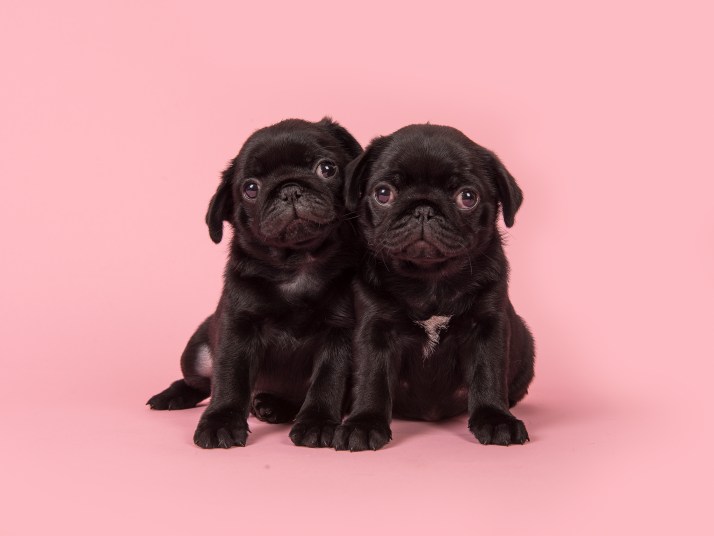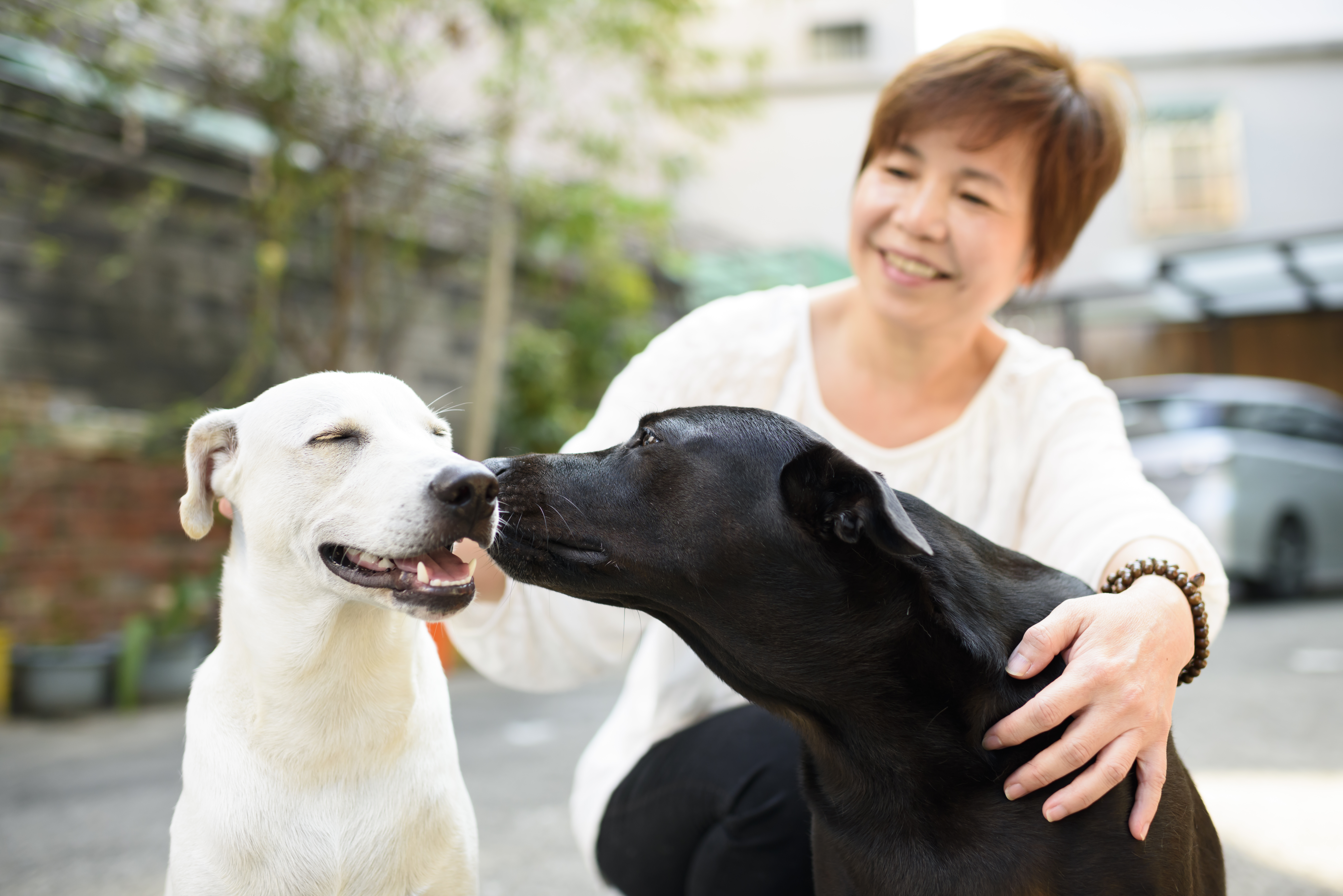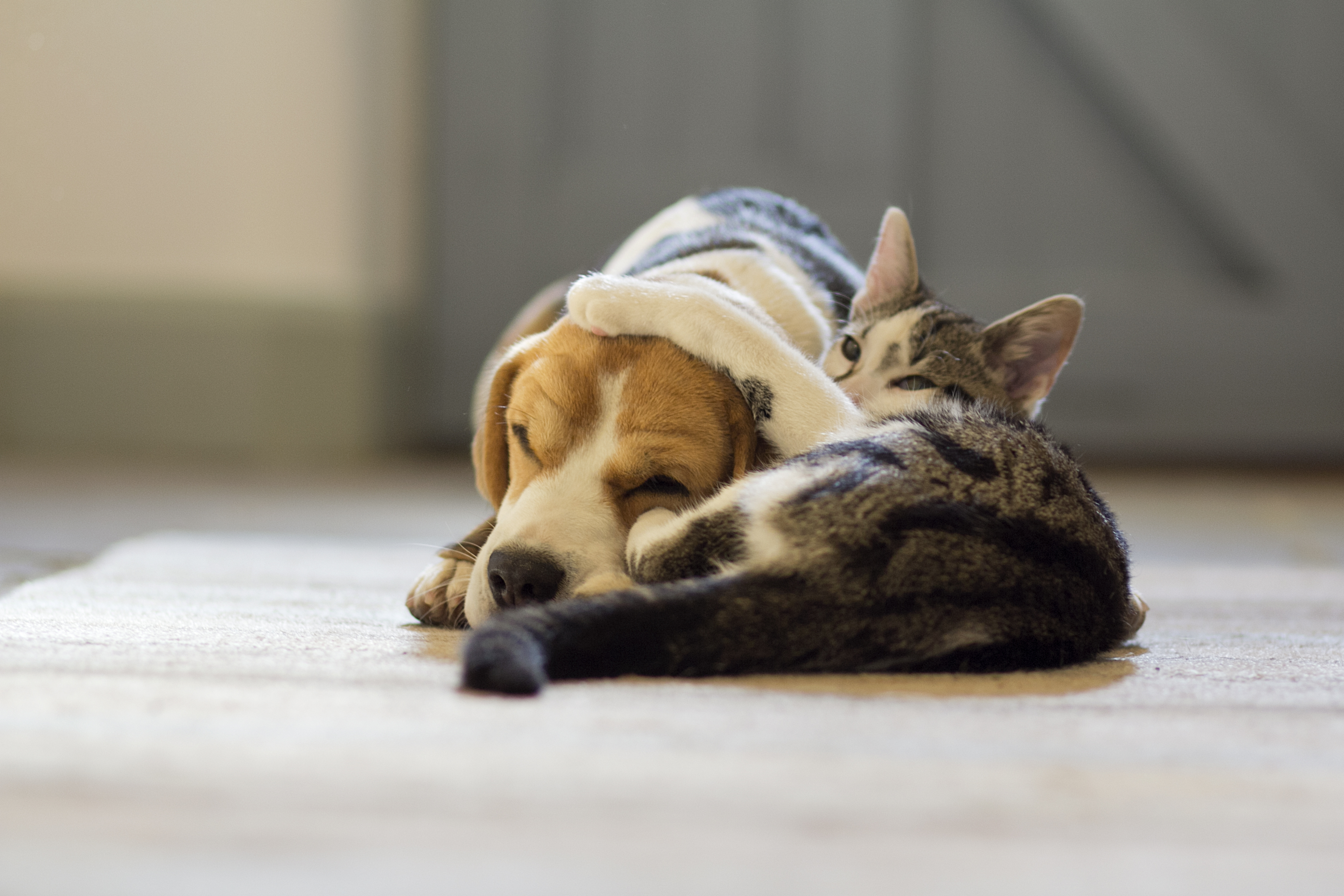Share this:

We all know dogs adore their humans, but do dogs feel love toward other dogs? Though canine romance doesn’t necessarily play out like it did for Lady and the Tramp, our good boys and girls can fall in love with us, each other, and other animals, according to some experts. Here’s how to tell if your pup is totally smitten.
As dog owners, we constantly want to know what our dogs are thinking — even when they’re sleeping. Experts find it difficult to study dogs’ emotions for a number of reasons. For starters, dogs and humans don’t speak the same language. Yes, pooches have different barks to express a variety of feelings, but researchers and owners can only guess at what exactly dogs are trying to say.
That said, experts believe dogs are capable of experiencing many of the same emotions as humans even though they don’t have the ability to express their feelings in our language. Dogs may not have a word for love, but they exhibit a certain set of behaviors that basically mean the same thing.
“If you define love as a long-term commitment — meaning they seek one another out when they’re apart, they’re happy when they’re reunited, they protect one another, they feed one another, they raise their children together — then, of course, non-human animals love each other,” Marc Bekoff, PhD, professor emeritus of ecology and evolutionary biology at the University of Colorado, told Vice.
In a 2017 interview with the New York Times, Gregory Berns, PhD, MD, a professor at Emory University, recounted an experiment he and his colleagues conducted to test whether dogs love us more than food. Berns and his team monitored dogs’ brain activity when they gave the pooch either a piece of hot dog or praise. After looking at the dogs’ reward centers in their brains, the researchers concluded that the dogs responded about the same in either the food or praise conditions. From that, they deduced that our pups love us at least as much as they enjoy food.


So, we know that pups can develop strong bonds with their owners and with other canines, but can dogs fall in love? Experts think dogs are capable of “falling in love” in a way, though it doesn’t look anything like a big-screen rom-com.
According to a May 2014 study published in the journal PNAS, positive reactions betweens dogs and humans or other dogs triggered a release of oxytocin in dogs’ brains. Oxytocin is known as the “love hormone,” and it plays an important role not only in social bonding.
Even though dogs don’t really fall into “romantic” love, they still can form deep and lasting bonds not only with their owners but also their fellow dogs. This could explain why your dog has a preference for another puppy at the dog park — his or her “best friend.” And this meaningful relationship isn’t limited to just other dogs. Some pooches prefer the company of their feline friends, so you can put to rest those stereotypes that cats and dogs are mortal enemies.


TEMPE, Ariz. — Xephos is not the author of “Dog Is Love: Why and How Your Dog Loves You,” one of the latest books to plumb the nature of dogs, but she helped inspire it. And as I scratched behind her ears, it was easy to see why.
He found this in his research with Bridgett vonHoldt, a molecular biologist at Princeton University. She and a team of researchers identified genes in dogs that in humans are associated with Williams-Beuren syndrome, a rare genetic disorder. One of the many symptoms of the syndrome is indiscriminate friendliness. Dr. Wynne and Dr. Udell worked with Dr. vonHoldt on a subsequent study of wolves and dogs that tied behavior and genetics together. They concluded that the genes associated with Williams-Beuren syndrome in humans underlie the friendliness of dogs compared to wolves.
Without doubt, dogs have feelings, she wrote, but she cautioned that just as certainly, those feelings were not the same as human feelings. Nor, she argued, should we assume that dogs are in between robot and homo sapiens on an emotional spectrum. She wrote in her book, “For all we know, dogs’ emotional experience is far more elaborate than ours.”
For now, we humans can at least enjoy the amiability of dogs. Looking at Xephos as we wrapped up our conversation, he said, “It’s not strange that she wants to interact with me. What’s strange is that she wants to be friends with you. Right?”
The second part of Dr. Wynne’s argument has to do with how social dogs are. There is no question that they bond with people in a way that other canines do not. Dr. Wynne recounted an experiment showing that as long as puppies spend 90 minutes a day, for one week, with a human any time before they are 14 weeks old, they will become socialized and comfortable with humans.
Overall, the results suggest that as dogs became domesticated, they might have developed a mutually beneficial ability to bond with humans the same way that we bond with each other. In an essay on the study published in Science, Evan MacLean and Brian Hare, both cognitive scientists at Duke, write, “dogs have taken advantage of our parental sensitivities—using behaviors such as staring into our eyes—to generate feelings of social reward and caretaking behavior.” In other words, dogs learned to evoke the same love that parents feel for their children.
Dog owners already know in their bones that they and their pets love one another. Now, a new study has confirmed it, finding that love is chemically apparent after dogs and their owners gaze into one another’s eyes.
The second part of the study tried to tease out whether the oxytocin actually caused the lengthened gaze. To do this, the researchers administered oxytocin to a new group of dogs, and the watched them interact with their owners. Strangely, oxytocin administered to female dogs led to much higher levels in both the dogs and their owners. But that effect wasn’t present in male dogs, and researchers weren’t sure why.
The researchers found that the owners whose dogs stared at them the longest had the highest oxytocin levels. Moreover, the oxytocin levels of owners and dogs were correlated: If an owner had high levels after they interacted, the dog likely did too.
The study, conducted by researchers at several Japanese universities and published in the journal Science, consisted of two parts. In the first, the researchers watched 30 dog owners interact with their dogs for half an hour, and then measured both human and dog levels of oxytocin. (Oxytocin, sometimes referred to as the “love hormone” or the “bonding hormone,” is fundamental to human intimacy; it is released during sex and creates attachment between couples, and also plays a role in mother-child bonding.)Advertisement
My Dogs Fall In Love With Our Baby | The Full Story
There was no way I wanted a dog, and I said as much to my partner when we moved in together. He grew up in a family with dogs – his parents are doggy even now, the owners of a glossy black labrador only slightly less tall than my partner’s mum. When that family get together, they reminisce about pets past, and brass-labelled urns that inter the ashy remains of their furry departed are arranged in a row along the top of the household piano. But no, I said, despite his pleading, we live in an apartment. We cannot take care of a dog.
My partner whimpered but there was no arguing about it. We first cohabited in north Melbourne – the flat was an exposed brick warehouse conversion, six floors up. Its clay balcony was too hot and shadeless for any mammal’s comfort, including mine. Yet if we lived in that place too long, it was perhaps because I was resolute in not wanting the dog my partner so desired. Yes, the canine aversion really was that strong.
When I was three, a whippet was brought home to the house, wrapped in a baby’s blanket – the puppy was a present for me, and I named him Jim. I remember how pale he was, how much I loved him, how he would sleep on top of my bed while I slept in it and how devastated I was when we moved back to Sydney from Canberra – and had to give him away. We were staying with Nanna, whose fibro house lacked the necessary fences for a whippet, and Jim got out. My mother relates the subsequent arrival at the door of a weeping, angry woman, a flurry of tears, the accusation that our Jim had murdered all her chickens. “And,” she wailed, “I’m pregnant!”
“Well, I don’t think that one can be pinned on the dog,” my mother offered. A fissure within was created by my childhood separation from the dog and perhaps it was deeper and more serious than I could understand, because by the time I was a teenager, I both hated and was terrified of dogs.
Let me hereby apologise to the kind American family who effectively had to intern their beloved hounds during my stay with them in Illinois, for the friendly pups pounced and I started screaming from the moment I entered their home. To the woman recovering from a car accident whose tiny, terrier companion had me so freaked out in a community meeting in London that I squatted on a plastic chair while friends formed a human shield between me and a fluffy antagonist barely larger than a slipper. To the boss in Sydney whose hapless, slobbering sidekick merely had to pad around a corner for me to be rendered frozen and bloodless with horror.
Then came the day my partner complained down the phone of a frustrating afternoon at work and I – distracted, unthinking – suggested he take a break and visit the pet shop near his office for a change of scene. Too soon, a second phone call. He’d seen a puppy. It was miserable, pet shops are awful, it had to be rescued, this instant. When my partner arrived home with puppy, puppy leashes, puppy collars, puppy pills, puppy pillows, puppy toys and puppy food, it was also with a puppy cage that reeked because the puppy had panic-shat itself in the train.
My partner cleaned it, and it cried. I wouldn’t touch it, I was furious. When he brought the shy little animal to the couch, I noticed it was swaddled in one of my blankets and relocated myself to the armchair in a huff. Despite the palatial accommodation my partner created for it in the back room of the house, the puppy sobbed all night. My partner went to comfort it, I lay in the bed and raged. “I have a deadline tomorrow!” I barked. When I woke up after but an hour of sleep, it was to the discovery that the dog had painted the walls of the room with its poo.
I fled to the office before my partner left for work and sobbed to my mother over the phone. When she pointed out the alternative was to move back in with her, I committed to just try to last the week. When I got home, my partner was sponging dog wee out of my rug. My rug. Mine.
The dog has since destroyed three of my blankets, my hot water bottle and a brocade for my hair, torn the zipper from my favourite dressing gown and succeeded in the relentless pillage of books, papers, bills, iPhone cords and household plants in my nominal (it seems, temporary) possession. The dog and I clearly share the same taste as he’s taken fatal bites out of five pairs of my shoes, and a noticeable munch out of the last pair of boots I have left to walk around in. This is not to imply the dog spares his own toys from his viciousness – we have taken to photographing the mortal remains of the shredded Mr Bear, Mr Dog, Froggy, Elfy and Little Bear to note their resemblance to mob hits.
In his attempts to comfort the monster he brought into our house, my partner – besotted – has placed beds for the dog on the verandah, in the lounge room, kitchen and library, though the dog’s favourite bed is in the dining room, on a floor cushion the shape of an elephant’s head – that obviously, once, belonged to me – which at night he curls into like a transformed rajah in a fairytale.
During the day, the dog prefers the couch. With me. It is here he is right now, asleep, curled under my arm while I write, his snout against my shoulder, his little paws reaching out to touch the edges of his own doggy dreams. And I stop to watch him, and I smile, and I tell the dog I love him, and he smiles for the gentle sound of the words and snuggles closer to me in his sleep.
It was my partner’s mum who finally explained the dog to me. “You just have to let him love you,” she said, the day the dog was bashing paint chunks from the back door, when I was trying to write and he just wouldn’t stop barking. “You just have to let him love you,” she repeated, and she repeated it until I calmed down, and the dog calmed down, and he stopped barking, and I let him back in.
And whether I’m pulling toy stuffing out of his mouth, or washing bits of a rat he’s mutilated from his fur, or dumping another wrecked pair of shoes in the bin, and smiling about it – laughing about it – happy about it, I do wonder (of course I wonder) if this may have indeed been the true source of my terror, all this time.